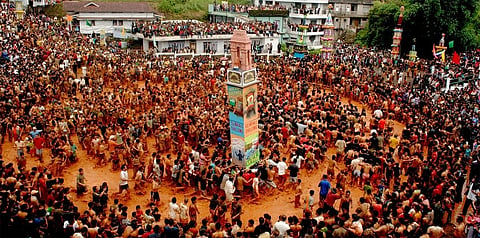
- Destinations
- Experiences
- Stay
- What's new
- Celebrating People
- Responsible Tourism
- CampaignsCampaigns
- Subscribe
- Buy Now

Meghalaya, nestled in Northeast India, boasts a tapestry of festivals that beautifully embody the profound connection between its tribal communities and the environment. Enriched by an agrarian heritage, these celebrations illuminate the vibrant spirit of the state. Among them, the Behdienkhlam Festival reigns supreme, captivating the hearts of the Pnar tribe.
With the monsoon as its backdrop, this grand harvest festival stands as a testament to the Pnars' deep-rooted adherence to the Niamtre tradition. "Behdienkhlam," which means "chasing away evil spirits," echoes the collective purpose of warding off malevolent forces that threaten the Pnars' well-being. Steeped in symbolism, it embodies the relentless pursuit of banishing the Demon of Cholera from their midst, according to the Meghalaya government website.
The festival is celebrated by the Pnar, a sub-tribal group of the Khasi people in Meghalaya. It is a chance for the tribe to appreciate their native cultural practices through various rituals and activities. Celebrated every year in July after the sowing period, people invoke the gods at this festival to ask for their blessings for a bountiful harvest. It is also considered to be one of the most important dance festivals of the Jaintia tribes. Both Jowai (in the West Jaintia Hills) and Tuberkmai (in the East Jaintia Hills) host the largest Behdienkhlam celebrations.
The Rituals
The Behdienkhlam Festival is a joyous celebration accompanied by the rains. People pray for a bountiful crop and seek blessings from their deities, U Mukhai, Mulong, Mooralong, and Musniang, during the festival. The ceremony and rituals are carried out over three days. The focus is on several traditional games that entertain both participants and spectators alike. During the Behdienkhlam Cultural Festival Tour, young men beat the rooftops of houses with bamboo poles as a symbolic act of warding off evil spirits, plagues, and diseases.
The daloi (leading religious figures of the community) perform many religious rites. Ancestors and clans are also honoured with offerings. As the crowds grow and the excitement mounts, the daloi lead prayers and traditions. An important ritual is the metaphorical slaying of demons. The ritual known as cher iung blai involves building a thatched hut of grass and bamboo. Male tribal members enter the hut with spears and kill the demons inside it symbolically.
One of the high points of the festival is "dat-lawakor," a football-like sport played with a wooden ball between teams during Behdienkhlam. Then there is the latan-bhang, which is a tug of war between members of the region's northern and southern areas. The winners are said to be blessed with a fruitful year and more.
Another interesting traditional game is the tussle between two opposing groups of people over a large, stripped wooden log. This allows the massive beam to traverse Wah-eit-nar, a muddy trench. The participants smear mud on one another as well. The polished logs of wood and beautifully designed "rots" (bamboo buildings) are taken through the neighbourhoods before being plunged into Aitnar (a pool of mud at Jowai) on the concluding day of the festival.).
There is a lot of excitement surrounding these rites, and the streets are packed. On the last day, people gather and dance to the sounds of traditional instruments like pipes and drums. Women, interestingly, do not dance since they are responsible for offering sacrificial food to the spirits of their ancestors.
For more information, click here.
Cover photo credits Meghalaya.gov.in
